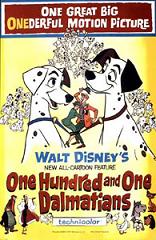 Andreas Deja was probably the youngest of Disney artists ever, since he first applied for a job as a Disney animator at the age of 10!
Andreas Deja was probably the youngest of Disney artists ever, since he first applied for a job as a Disney animator at the age of 10!
Born in Poland and raised in Germany, he remembers writing to the studio immediately after seeing The Jungle Book. The studio wrote back to him, explaining that they were fully staffed but they were always on the lookout for new talent. This response offered him the encouragement he needed and motivated him to work hard toward his goal. At the age of 20, after completing his studies, he applied again and was accepted.
Under the guidance of Disney Legend Eric Larson, Andreas Deja began an incredible career at Disney made of artistic breakthroughs and respect for heritage. He served as the supervising animator for the title character in Disney’s epic animated comedy Hercules, was the supervising animator for Lilo, the little Hawaiian girl in Lilo & Stitch, and animated Bambi’s father, the Great Prince, in Bambi II from DisneyToon Studios. More recently, he animated Goofy for the new short film, How to Hook Up Your Home Theater, and has contributed his talents to the upcoming short film, The Ballad of Nessie, as well. He is currently working on the upcoming Walt Disney Feature Animation film The Princess and the Frog, which marks the company’s much-anticipated return to hand drawn animation.
But Andreas Deja is also famous for his animation of some of the greatest Disney modern villains, such as Gaston (Beauty and the Beast), Jafar (Aladdin) and Scar (The Lion King). No doubt, then, that he was the ideal person to talk with about the outstanding Disney villain that is Cruella de Vil and the history of One Hundred and One Dalmatians…
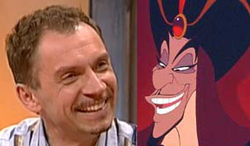
 Animated Views: Mr. Deja, you’re not only a legendary animator, but also an expert in Disney history. Can you tell me about that aspect of your work?
Animated Views: Mr. Deja, you’re not only a legendary animator, but also an expert in Disney history. Can you tell me about that aspect of your work?
Andreas Deja: I’m usually being interviewed when a classic film comes out because I think I have a fairly good knowledge of the filmmaking and the animators. I knew most of the animators who worked on these films like One Hundred and One Dalmatians. When I came over to Los Angeles in 1980, even though most of these animators had retired – there was only one that was still teaching, that was Eric Larson – they were still in town. I mean, I could still go to see Frank Thomas and Ollie Johnston. They just lived a few minutes away from me and I could visit them and have dinner with them and talk to them about these films. Mark Davis also lived very close by. We became friends over the years. So, it was a real bonus for me to have had that chance to talk to these people. And because I know all the stories and all the ups and downs that they went through making these movies – it really wasn’t easy always – I can relate those stories now to nowadays audiences and talk about it, and I actually enjoy that aspect very much.
AV: Were you involved in the restoration process of One Hundred and One Dalmatians?
AD: No, I was not involved in that one. I’m actually involved in the restoration of the next release,which is Sleeping Beauty.
AV: One Hundred and One Dalmatians was the first feature-length animated film using the Xerox technique. Can you tell me about the principles of this aesthetic?
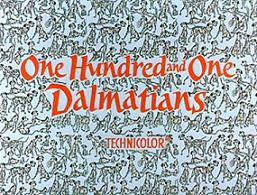 AD: It was a breakthrough, as you know. It was something brand new that they hadn’t done before. But the reason why they did this was, believe it or not, to save money. Because Sleeping Beauty had just come out and was not an initial success. It made some money later. And when it was made, it has just got too expensive. So, they had to think of some kind of way to bring the costs down or close the studio. It was as simple as that. So, it was up to a kind of a devious technician called Ub Iwerks, the original Mickey Mouse animator and one of Walt’s partners in the 20s, to find something. Ub Iwerks got together with Ken Anderson, the art director and said: “we have to find a way to somehow shorten the process of making these films”. And so, they came up with the idea of rather than hand-inking all the animators’ drawings onto these cels with different colored inks, which was a long and tedious process, they chose to eliminate that and instead just take the animators’ drawings and Xerox them and copy them on cel.
AD: It was a breakthrough, as you know. It was something brand new that they hadn’t done before. But the reason why they did this was, believe it or not, to save money. Because Sleeping Beauty had just come out and was not an initial success. It made some money later. And when it was made, it has just got too expensive. So, they had to think of some kind of way to bring the costs down or close the studio. It was as simple as that. So, it was up to a kind of a devious technician called Ub Iwerks, the original Mickey Mouse animator and one of Walt’s partners in the 20s, to find something. Ub Iwerks got together with Ken Anderson, the art director and said: “we have to find a way to somehow shorten the process of making these films”. And so, they came up with the idea of rather than hand-inking all the animators’ drawings onto these cels with different colored inks, which was a long and tedious process, they chose to eliminate that and instead just take the animators’ drawings and Xerox them and copy them on cel.
In doing so, it would loose that delicate multicolored outline look for the characters. You would only have black lines. Then, Ken Anderson was arguing: “look, it’s a movie about black and white dogs. Let’s be very graphic with this and let’s not only have these black sketchy outlines for the characters. I want them in my backgrounds as well”. So, they used very bold black lines in the architecture and so forth so it was a very unified sketchy look, if you want. Aesthetically, it’s more about sketch than about painting. Of course, the animators were real excited about this because they could see their own drawings on the screen. How could an artist not love something like that? So, this technique updated animation and showed audiences a whole new look. But it also saved money and so, they could continue doing more movies. It was a very, very important film for the Studio.

AV: Did that change the way animators animated at that time?
AD: Basically, nothing changed. They didn’t cut costs in terms of animation. It was still 12 to 24 drawings per second. They didn’t try to limit the animation that was still fully realized. So, the animators’ job really didn’t change. What they did do, though, is, in order to preserve the animators’ drawings, they didn’t clean up these loose sketchy animators’ drawing anymore.
Usually, you would have an assistant who would take a new sheet of paper over that loose drawing and trace it one more time in a very clean single outline. They actually worked with the animators’ drawings. So, they called that “touch up”. They didn’t call it “clean up”, they called it “touch up” meaning they were taking an eraser and maybe would take a few lines that were a little too sketchy and erase those lines, and then leave the drawing alone. And that would then go to the Xerox department, then copied and then painted. So, that’s why the characters have this sort of lightly sketchy look to them.
AV: One Hundred and One Dalmatians is one of the most popular of Disney’s films, but it is said that it was far from being Walt Disney’s favorite.
AD: I think that has to do with the style, with the Xerox line, that was new and somewhat shocking. I think Walt, when he saw the first tests of the film, was not impressed because it looked unfinished to him. Even though he saw the enthusiasm of the animators who just loved it because their drawings were on the screen for the first time, it took him longer to get used to the idea that you could a whole animated film as a sketch. He did like the movie later on but it took him a little while to get used to it.
AV: Do you think that this sketchy look of One Hundred and One Dalmatians and Walt’s reaction to it may be an explanation for the fact that, for example on Jungle Book, there is still the Xerox line for the characters, but the background are not so much sketchy.
AD: Right. They went back to a little bit of a painterly style. The cels are Xeroxed on Jungle Book, as you know, but they’re not as loose as in One Hundred and One Dalmatians. They went a little tighter, a little cleaner with it. I’ve seen in the archives several versions of the jungle backdrop. Initially, they would have something more graphic in mind, with a really dark and mysterious jungle. But then because of the story Walt wanted, he wanted a light jungle that is fun and not scary. They went much brighter with the colors that became much more pleasant and more painterly.
AV: Can you tel me about your relationship to Marc Davis?
 AD: I met Marc and his wife Alice in 1984, when the Olympic Games were in Los Angeles. The Studio sent a small group of people and Marc and Alice to show animated movies to the athletes. So, I was part of that small group, that means, for several days, we would really hang out with Marc and Alice and we would show movies like Sleeping Beauty and One Hundred and One Dalmatians and so forth. Marc was so easy to approach. He loved talking with young people. So, that, to me, was really, really meaningful. They were open to my questions and my interest and my passion in animation. It’s gone into a friendship over the years. I’ve been to their house many, many times and asked all the questions I wanted to ask about so many things. Interestingly, when you go to their house, it’s like a museum. You would have all his fine art also on the walls. Marc had a career as an animator, of course, at Disney, but he also did fine art. Semi-abstract paintings, drawings, watercolors… He tried all these techniques and it was an overwhelming experience to see all that. He became a kind of mentor to me over the years. He told me: “look, I’m actually an artist first. And then I’m animator. I’ve done some sculpting, watercolor, I’ve tried myself on all these different mediums”, and he encouraged me also to broaden my horizon and try different artistic outlets. So, he was a very, very important figure in my life.
AD: I met Marc and his wife Alice in 1984, when the Olympic Games were in Los Angeles. The Studio sent a small group of people and Marc and Alice to show animated movies to the athletes. So, I was part of that small group, that means, for several days, we would really hang out with Marc and Alice and we would show movies like Sleeping Beauty and One Hundred and One Dalmatians and so forth. Marc was so easy to approach. He loved talking with young people. So, that, to me, was really, really meaningful. They were open to my questions and my interest and my passion in animation. It’s gone into a friendship over the years. I’ve been to their house many, many times and asked all the questions I wanted to ask about so many things. Interestingly, when you go to their house, it’s like a museum. You would have all his fine art also on the walls. Marc had a career as an animator, of course, at Disney, but he also did fine art. Semi-abstract paintings, drawings, watercolors… He tried all these techniques and it was an overwhelming experience to see all that. He became a kind of mentor to me over the years. He told me: “look, I’m actually an artist first. And then I’m animator. I’ve done some sculpting, watercolor, I’ve tried myself on all these different mediums”, and he encouraged me also to broaden my horizon and try different artistic outlets. So, he was a very, very important figure in my life.
AV: One of the characters Marc Davis did on One Hundred and One Dalmatians was Anita, and he did that along with Milt Kahl. You can’t imagine more remote personalities. Can you tell me about that?
 AD: Well, they had a different way of working. All animators have their own working method. People might think there’s only one way of doing Disney animation and there really isn’t. There are no tricks, there are no secrets. It’s just expressing yourself on paper. If we could get a little technical for a second, I would say that Marc Davis would do every second or every other drawing on Cruella. He would do drawing #1, 3, 5, 7, 9 and so forth and then he would have an assistant who would be doing the inbetween drawings. That’s a very unusual way of structuring a scene where you do every other drawings.
AD: Well, they had a different way of working. All animators have their own working method. People might think there’s only one way of doing Disney animation and there really isn’t. There are no tricks, there are no secrets. It’s just expressing yourself on paper. If we could get a little technical for a second, I would say that Marc Davis would do every second or every other drawing on Cruella. He would do drawing #1, 3, 5, 7, 9 and so forth and then he would have an assistant who would be doing the inbetween drawings. That’s a very unusual way of structuring a scene where you do every other drawings.
Sometimes, you do a drawing where a character is just moving very little and you would do the first drawing and then drawing#29. And all these inbetween drawings, that are very close to each other because the character is hardly moving, you would have all those drawings done by an assistant. But Marc didn’t do that way and that’s why he did so many drawings for his animation of Cruella. He was just like saying: “the more drawings I do for my scene, the more it is really my scene and the more I can control it”. Milt Kahl worked in a different way. He would structure it more the way to really find the key-moments of the character, the drawings that really tell the story or tell the acting. And then, he would leave the rest to an assistant. He would give his assistant more of a frame. But the interesting thing is that Marc and Milt had a mutual admiration. They both adored each other’s work. They were a great team, just like Frank and Ollie were a team, worked together. They were really best friends for their whole life!
AV: But, certainly, his most memorable character on One Hundred and One Dalmatians is Cruella de Vil. How do you see his animation of this larger-than-life character?
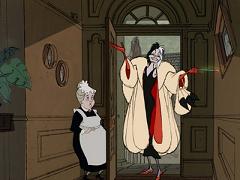 AD: It’s probably the most fun Marc ever had with a character. A lot of the time before that, he had worked on what he would called his “leading ladies”. He did Aurora and Maleficent in Sleeping Beauty, he animated Cinderella, he did Alice and Wendy and Tinker Bell. Not that he didn’t have fun on those characters but those are the kind of assignments where you have to be very, very careful with what you’re drawing. When you draw Alice, you have to be delicate with her face and her hands have to be nice, all things that have to be realistic. When you have a character like Cruella with her grotesque head and very caricatured design – she’s very skinny and phony with her gigantic, oversized fur coat – there is so much to play with. Like when she walks into the house and turns around with her fur coat flying around her. These are things animators have a lot of fun with. So, he went really far with her in making her villainesque and grotesque; evil but also funny. It’s really a combination of both. You almost can’t take your eyes off her, you’re sort of fascinated by her! He was able to get all that in, you know. She’s scary but funny at the same time.
AD: It’s probably the most fun Marc ever had with a character. A lot of the time before that, he had worked on what he would called his “leading ladies”. He did Aurora and Maleficent in Sleeping Beauty, he animated Cinderella, he did Alice and Wendy and Tinker Bell. Not that he didn’t have fun on those characters but those are the kind of assignments where you have to be very, very careful with what you’re drawing. When you draw Alice, you have to be delicate with her face and her hands have to be nice, all things that have to be realistic. When you have a character like Cruella with her grotesque head and very caricatured design – she’s very skinny and phony with her gigantic, oversized fur coat – there is so much to play with. Like when she walks into the house and turns around with her fur coat flying around her. These are things animators have a lot of fun with. So, he went really far with her in making her villainesque and grotesque; evil but also funny. It’s really a combination of both. You almost can’t take your eyes off her, you’re sort of fascinated by her! He was able to get all that in, you know. She’s scary but funny at the same time.
AV: You had your Cruella in Yzma at some point, I guess, when The Emperor’s New Groove was still Kingdom of the Sun.
AD: I think so. Dale Baer [Yzma’s eventual animator] and I worked both on the movie in the early stages. At that time, she looked a little different but then, we ran into some story issues and I actually switched assignments. I ended working on Lilo & Stitch.
AV: From Gaston to Yzma [above], you’re considered an expert in the matter of Disney villains. What did Marc Davis’ influence bring you when it came to your own modern villain animation?
AD: It’s really a matter of diving into your character and have fun with it. I was able to do that with most of the villains that I did. I had a lot of fun with Scar because, just like Cruella, you cannot make a villain just bad, just evil. If it were the only characteristic your villain had, it would be flat and boring. You have to develop other little things about them. Maybe they have a sidekick, maybe they have eccentric qualities on top of being bad. So, when I was animating Scar, I loved the fact that he really enjoys being evil. He’s really, really evil in terms of story. He kills his brother and blames his nephew for the murder. How bad can you get? Also, he has a way with words, you word, the way he would be sarcastic to his brother Mufasa. And, of course, he wouldn’t get involved in any kind of fight. He has hyenas doing that. So, I tried to create a character with Scar that wouldn’t just be bad, but also would be interesting, you know, that would be kind of fascinating. And then, for Jafar, the same way. Jafar has this theatrical quality. He wouldn’t walk. He would just fly over the floor. These are all things that you develop on top of the character being just bad, which is not enough. You always have to do more!
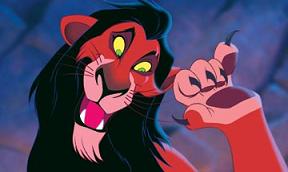
Our special appreciation to Andreas Deja and to Mac McLean for this interview.



